Corporate Accounting Homework Solution - Semester 1, University Name
VerifiedAdded on 2023/01/06
|10
|1139
|32
Homework Assignment
AI Summary
This document presents a comprehensive solution to a corporate accounting homework assignment, covering a range of topics. The solution begins with journal entries and ledger accounts related to share applications and equity share capital. It then delves into the reasons and methods for reducing share capital, differentiating between share buybacks and capital reduction, and outlining different types of debt instruments. The assignment continues with an analysis of corporate expansion through asset acquisition, including journal entries for business purchase and the calculation of goodwill. It also addresses consolidated financial statements, including the elimination of intra-group transactions such as dividends and unrealized profits. The solution provides entries for eliminating investment in subsidiaries, including the calculation of non-controlling interest and acquisition entries. It also addresses financial statement analysis, including salary expense, PPE, retained earnings, and accounts receivable. The assignment concludes with the preparation of relevant journal entries and account extracts.
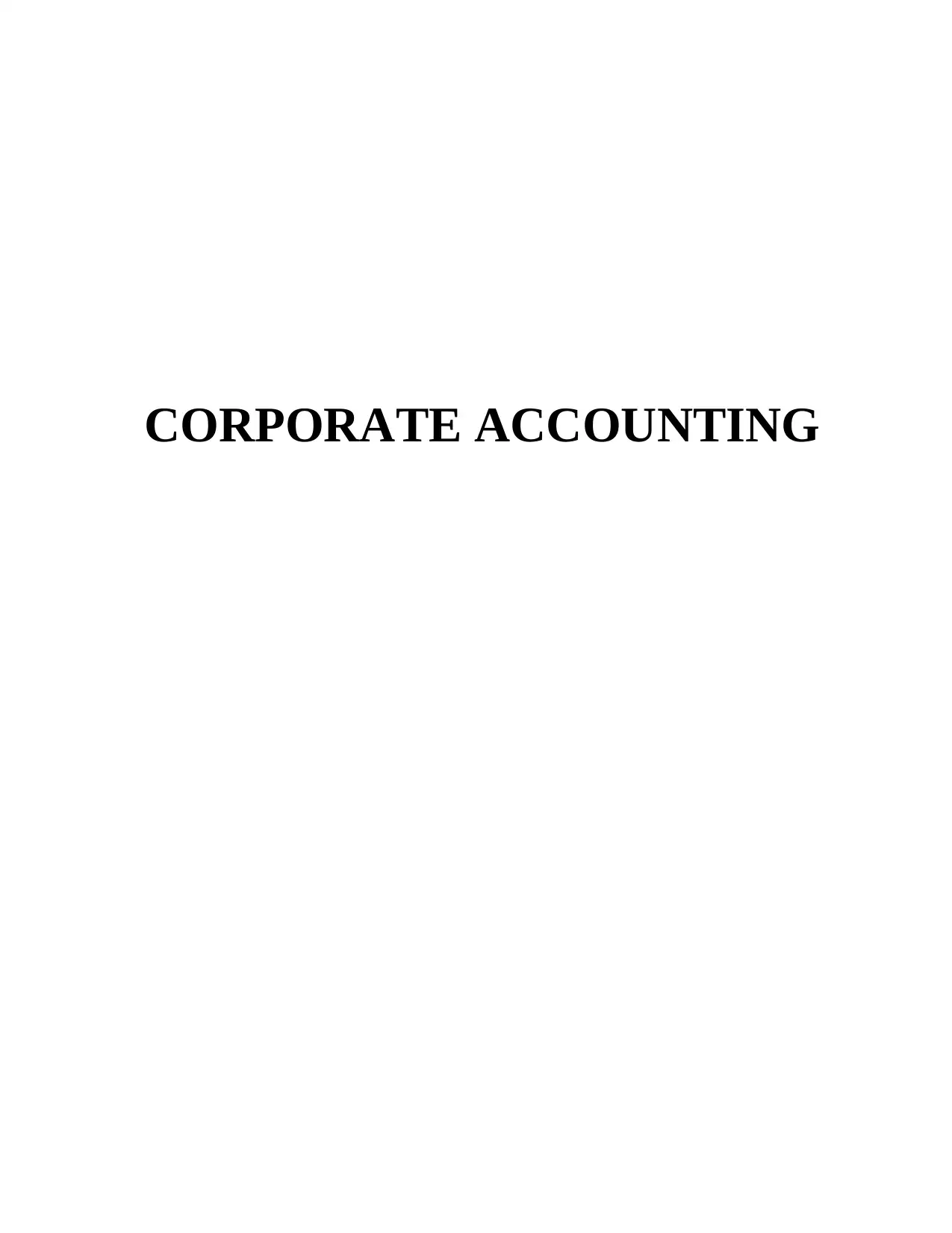
CORPORATE ACCOUNTING
Paraphrase This Document
Need a fresh take? Get an instant paraphrase of this document with our AI Paraphraser

TABLE OF CONTENTS
Question 1........................................................................................................................................1
a) .................................................................................................................................................1
b)..................................................................................................................................................1
Question 2........................................................................................................................................1
a) .................................................................................................................................................1
b)..................................................................................................................................................2
c)..................................................................................................................................................2
d)..................................................................................................................................................2
Question 3........................................................................................................................................3
a)..................................................................................................................................................3
b) .................................................................................................................................................3
Question 4........................................................................................................................................4
a)..................................................................................................................................................4
b)..................................................................................................................................................5
c)..................................................................................................................................................5
Question 5........................................................................................................................................5
a)..................................................................................................................................................5
b)..................................................................................................................................................6
Question 6........................................................................................................................................6
a)..................................................................................................................................................6
b)..................................................................................................................................................6
c)..................................................................................................................................................7
d)..................................................................................................................................................7
REFERENCES................................................................................................................................8
Question 1........................................................................................................................................1
a) .................................................................................................................................................1
b)..................................................................................................................................................1
Question 2........................................................................................................................................1
a) .................................................................................................................................................1
b)..................................................................................................................................................2
c)..................................................................................................................................................2
d)..................................................................................................................................................2
Question 3........................................................................................................................................3
a)..................................................................................................................................................3
b) .................................................................................................................................................3
Question 4........................................................................................................................................4
a)..................................................................................................................................................4
b)..................................................................................................................................................5
c)..................................................................................................................................................5
Question 5........................................................................................................................................5
a)..................................................................................................................................................5
b)..................................................................................................................................................6
Question 6........................................................................................................................................6
a)..................................................................................................................................................6
b)..................................................................................................................................................6
c)..................................................................................................................................................7
d)..................................................................................................................................................7
REFERENCES................................................................................................................................8
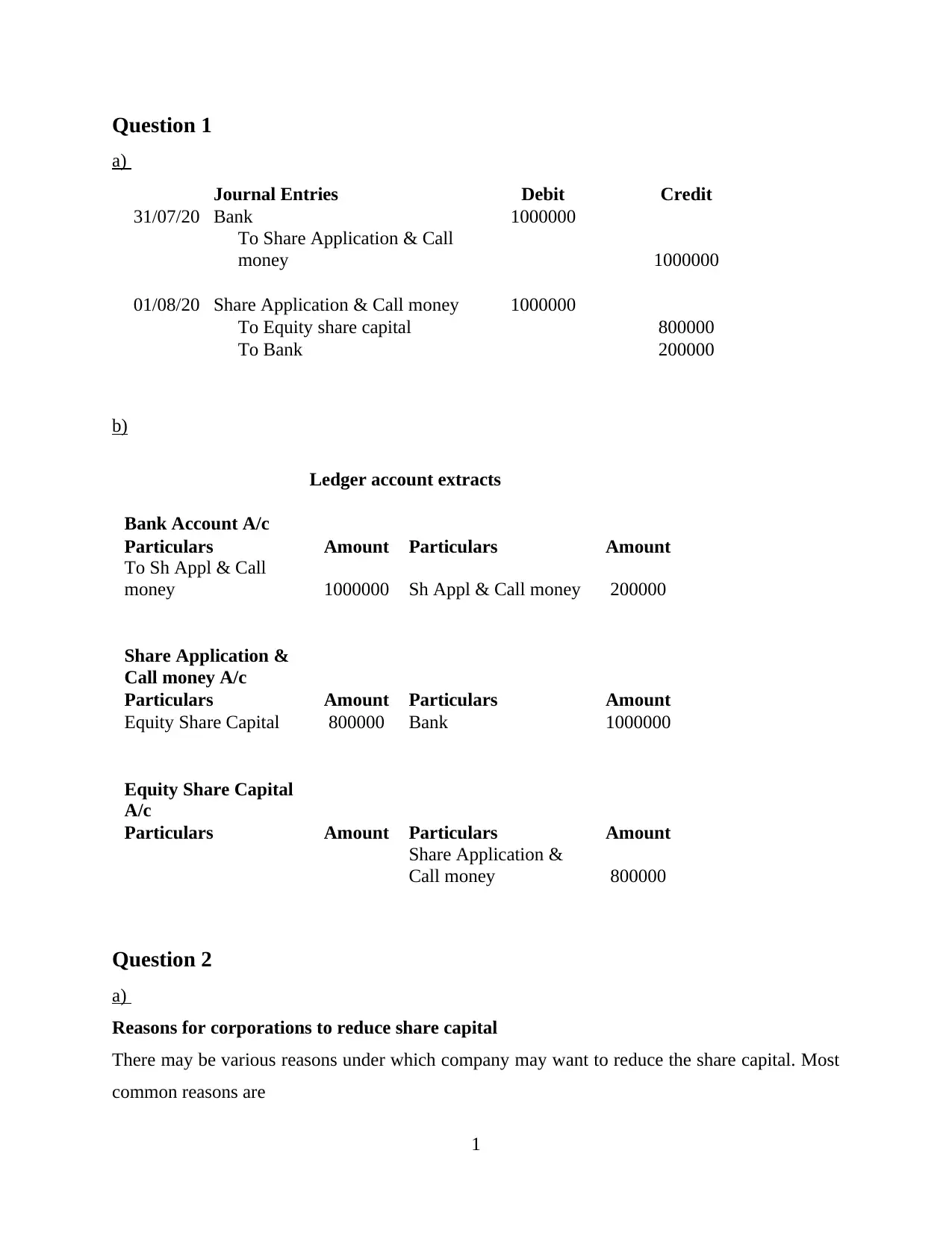
Question 1
a)
Journal Entries Debit Credit
31/07/20 Bank 1000000
To Share Application & Call
money 1000000
01/08/20 Share Application & Call money 1000000
To Equity share capital 800000
To Bank 200000
b)
Ledger account extracts
Bank Account A/c
Particulars Amount Particulars Amount
To Sh Appl & Call
money 1000000 Sh Appl & Call money 200000
Share Application &
Call money A/c
Particulars Amount Particulars Amount
Equity Share Capital 800000 Bank 1000000
Equity Share Capital
A/c
Particulars Amount Particulars Amount
Share Application &
Call money 800000
Question 2
a)
Reasons for corporations to reduce share capital
There may be various reasons under which company may want to reduce the share capital. Most
common reasons are
1
a)
Journal Entries Debit Credit
31/07/20 Bank 1000000
To Share Application & Call
money 1000000
01/08/20 Share Application & Call money 1000000
To Equity share capital 800000
To Bank 200000
b)
Ledger account extracts
Bank Account A/c
Particulars Amount Particulars Amount
To Sh Appl & Call
money 1000000 Sh Appl & Call money 200000
Share Application &
Call money A/c
Particulars Amount Particulars Amount
Equity Share Capital 800000 Bank 1000000
Equity Share Capital
A/c
Particulars Amount Particulars Amount
Share Application &
Call money 800000
Question 2
a)
Reasons for corporations to reduce share capital
There may be various reasons under which company may want to reduce the share capital. Most
common reasons are
1
⊘ This is a preview!⊘
Do you want full access?
Subscribe today to unlock all pages.

Trusted by 1+ million students worldwide

To create or increase the distributable reserves to enable the payment for future dividends
to shareholders
For returning the surplus capital to the shareholders
For facilitating buyback or share or redemption of the shares
Part of the management scheme
b)
Methods of reducing share capital
Reducing the liability of the shares in respect of share capital which is not paid up.
By cancelling the paid up capital that is lost or unrepresented by the available assets
By paying off paid up share capital that is in excess.
c)
Difference between share buyback and capital reduction
Buyback of shares
When company is having surplus distributable funds it could declare buyback for own
shares or dividend. Buyback of the shares refers to when company acquires the shares from the
existing shareholders and cancel the shares. Buyback is also made to exit shareholder from
company, returning cash to the shareholders or for operating employee incentive scheme.
Reduction of share capital
It is different from buyback as the shares are not purchased by the company. In this case
the paid up share capital of company is reduced for various reasons. Reduction is made generally
at time of internal reconstruction. It is made for returning share capital, creating distributable
reserves or for supporting redemption or buy back.
d)
Different types of debt instruments
Debt instrument could be in any form electronic or paper form. Debt instruments provide higher
and fixed returns. Different debt instruments are
Debentures
Bonds
Leases
Promissory notes
Bills of exchange
2
to shareholders
For returning the surplus capital to the shareholders
For facilitating buyback or share or redemption of the shares
Part of the management scheme
b)
Methods of reducing share capital
Reducing the liability of the shares in respect of share capital which is not paid up.
By cancelling the paid up capital that is lost or unrepresented by the available assets
By paying off paid up share capital that is in excess.
c)
Difference between share buyback and capital reduction
Buyback of shares
When company is having surplus distributable funds it could declare buyback for own
shares or dividend. Buyback of the shares refers to when company acquires the shares from the
existing shareholders and cancel the shares. Buyback is also made to exit shareholder from
company, returning cash to the shareholders or for operating employee incentive scheme.
Reduction of share capital
It is different from buyback as the shares are not purchased by the company. In this case
the paid up share capital of company is reduced for various reasons. Reduction is made generally
at time of internal reconstruction. It is made for returning share capital, creating distributable
reserves or for supporting redemption or buy back.
d)
Different types of debt instruments
Debt instrument could be in any form electronic or paper form. Debt instruments provide higher
and fixed returns. Different debt instruments are
Debentures
Bonds
Leases
Promissory notes
Bills of exchange
2
Paraphrase This Document
Need a fresh take? Get an instant paraphrase of this document with our AI Paraphraser
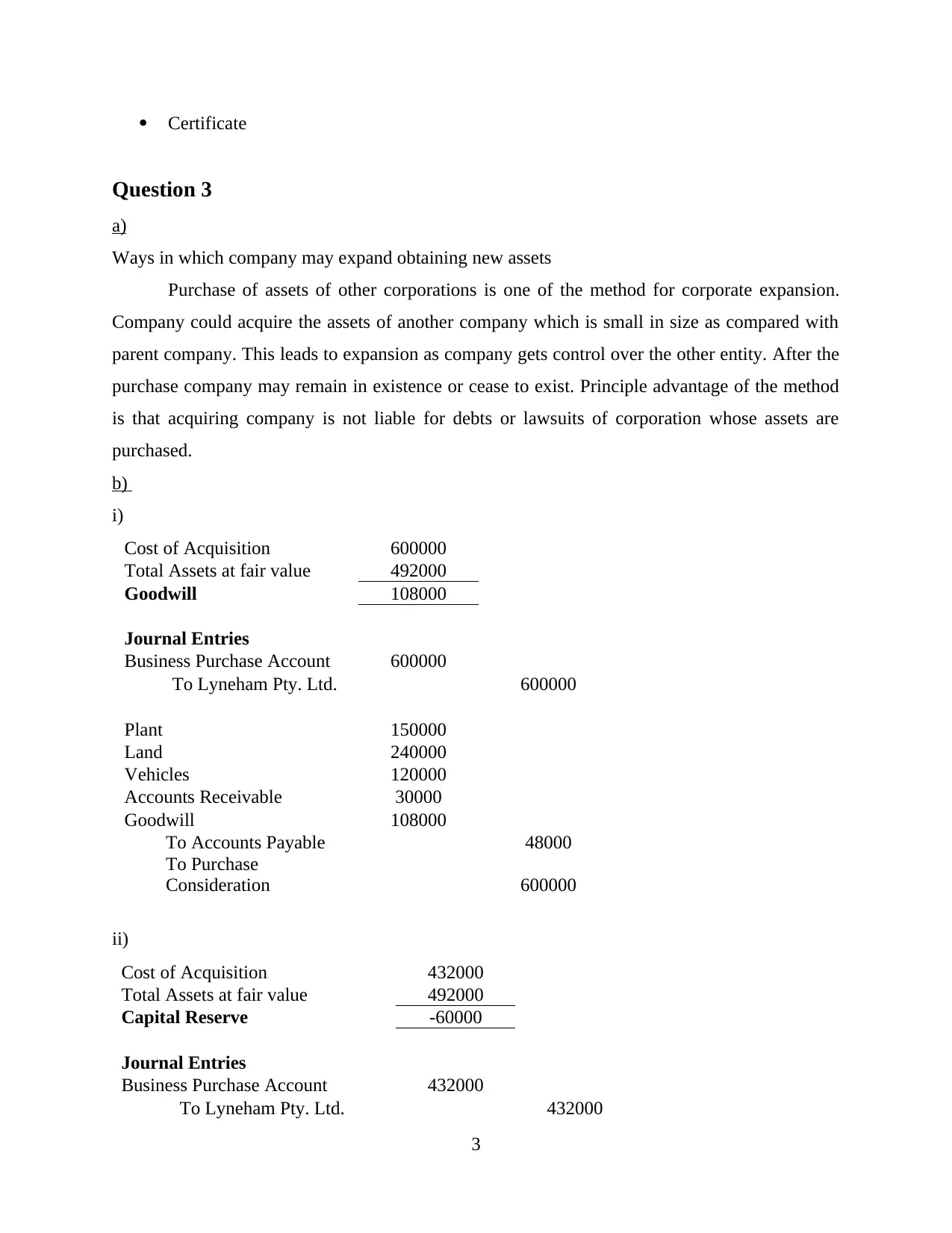
Certificate
Question 3
a)
Ways in which company may expand obtaining new assets
Purchase of assets of other corporations is one of the method for corporate expansion.
Company could acquire the assets of another company which is small in size as compared with
parent company. This leads to expansion as company gets control over the other entity. After the
purchase company may remain in existence or cease to exist. Principle advantage of the method
is that acquiring company is not liable for debts or lawsuits of corporation whose assets are
purchased.
b)
i)
Cost of Acquisition 600000
Total Assets at fair value 492000
Goodwill 108000
Journal Entries
Business Purchase Account 600000
To Lyneham Pty. Ltd. 600000
Plant 150000
Land 240000
Vehicles 120000
Accounts Receivable 30000
Goodwill 108000
To Accounts Payable 48000
To Purchase
Consideration 600000
ii)
Cost of Acquisition 432000
Total Assets at fair value 492000
Capital Reserve -60000
Journal Entries
Business Purchase Account 432000
To Lyneham Pty. Ltd. 432000
3
Question 3
a)
Ways in which company may expand obtaining new assets
Purchase of assets of other corporations is one of the method for corporate expansion.
Company could acquire the assets of another company which is small in size as compared with
parent company. This leads to expansion as company gets control over the other entity. After the
purchase company may remain in existence or cease to exist. Principle advantage of the method
is that acquiring company is not liable for debts or lawsuits of corporation whose assets are
purchased.
b)
i)
Cost of Acquisition 600000
Total Assets at fair value 492000
Goodwill 108000
Journal Entries
Business Purchase Account 600000
To Lyneham Pty. Ltd. 600000
Plant 150000
Land 240000
Vehicles 120000
Accounts Receivable 30000
Goodwill 108000
To Accounts Payable 48000
To Purchase
Consideration 600000
ii)
Cost of Acquisition 432000
Total Assets at fair value 492000
Capital Reserve -60000
Journal Entries
Business Purchase Account 432000
To Lyneham Pty. Ltd. 432000
3
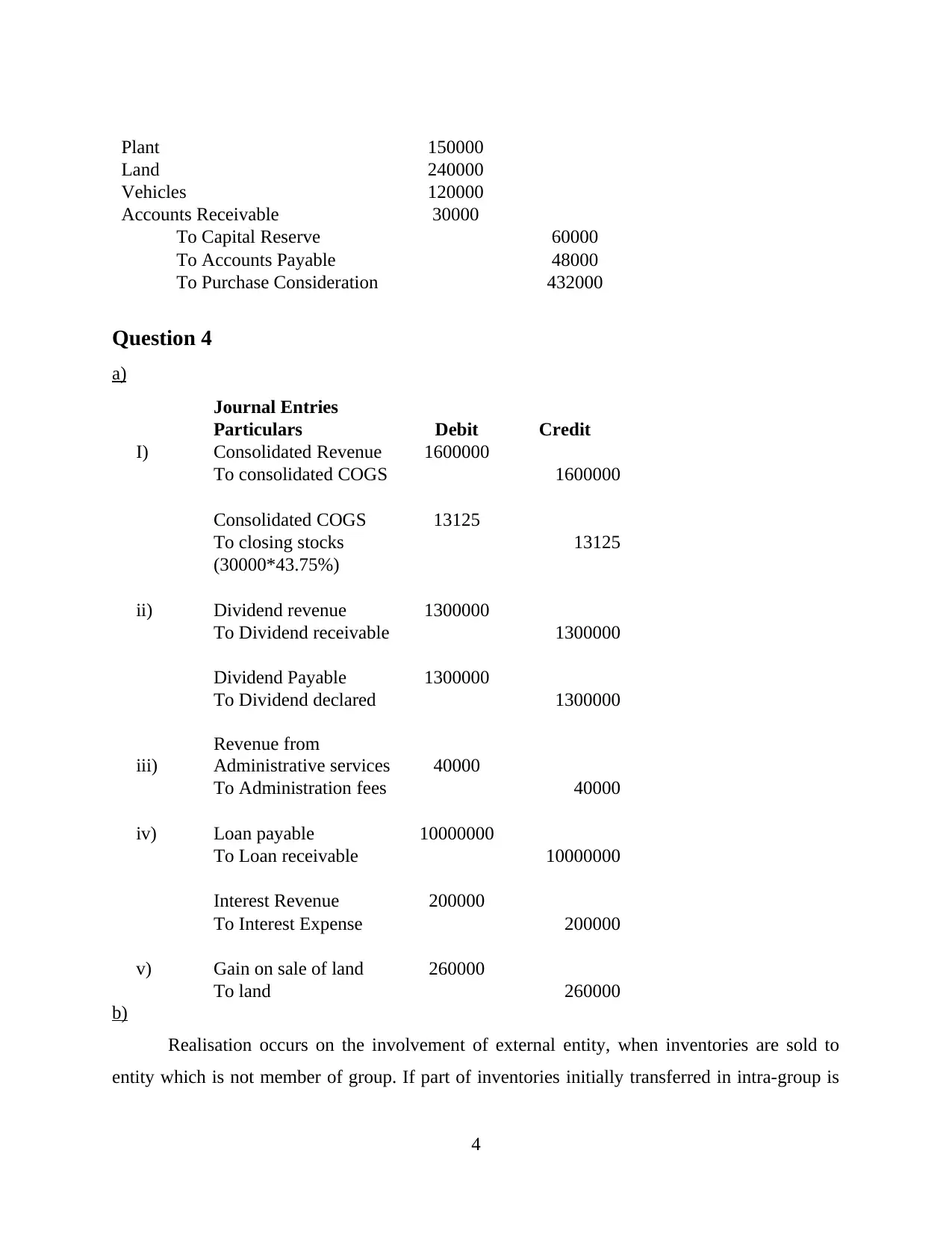
Plant 150000
Land 240000
Vehicles 120000
Accounts Receivable 30000
To Capital Reserve 60000
To Accounts Payable 48000
To Purchase Consideration 432000
Question 4
a)
Journal Entries
Particulars Debit Credit
I) Consolidated Revenue 1600000
To consolidated COGS 1600000
Consolidated COGS 13125
To closing stocks 13125
(30000*43.75%)
ii) Dividend revenue 1300000
To Dividend receivable 1300000
Dividend Payable 1300000
To Dividend declared 1300000
iii)
Revenue from
Administrative services 40000
To Administration fees 40000
iv) Loan payable 10000000
To Loan receivable 10000000
Interest Revenue 200000
To Interest Expense 200000
v) Gain on sale of land 260000
To land 260000
b)
Realisation occurs on the involvement of external entity, when inventories are sold to
entity which is not member of group. If part of inventories initially transferred in intra-group is
4
Land 240000
Vehicles 120000
Accounts Receivable 30000
To Capital Reserve 60000
To Accounts Payable 48000
To Purchase Consideration 432000
Question 4
a)
Journal Entries
Particulars Debit Credit
I) Consolidated Revenue 1600000
To consolidated COGS 1600000
Consolidated COGS 13125
To closing stocks 13125
(30000*43.75%)
ii) Dividend revenue 1300000
To Dividend receivable 1300000
Dividend Payable 1300000
To Dividend declared 1300000
iii)
Revenue from
Administrative services 40000
To Administration fees 40000
iv) Loan payable 10000000
To Loan receivable 10000000
Interest Revenue 200000
To Interest Expense 200000
v) Gain on sale of land 260000
To land 260000
b)
Realisation occurs on the involvement of external entity, when inventories are sold to
entity which is not member of group. If part of inventories initially transferred in intra-group is
4
⊘ This is a preview!⊘
Do you want full access?
Subscribe today to unlock all pages.

Trusted by 1+ million students worldwide

sold to the external parties by end of the period, only part of intra-group profits related to
inventories on sold are realised.
c)
Rules for elimination of intra-group dividend transactions
For elimination of dividend
Declared by Subsidiary
Dividend revenue
To Dividend receivable
Dividend Payable
To Dividend declared
Declared By Parent
Dividend Payable
To Dividend Proposed
Question 5
a)
Elimination of
Investment in Amazon
Ltd
Amazon
Ltd (S)
$,000
Nile Ltd (70% of
Amazon) (P)
$,000 30% NCI $,000
Fair Value of
consideration transferred 57400 24600
Less: FV of identifiable
assets acquired &
liabilities assumed
Share capital on
acquisition date 52000 36400
General reserve-
acquisition date 20000 14000
Retained earnings-
acquisition date 10000 7000
Fair value adjustment 8000
Goodwill on acquisition 2260
Non-controlling interest 24600
b)
Acquisition Entries
Investment in Amazon 80000
To Bank 80000
5
inventories on sold are realised.
c)
Rules for elimination of intra-group dividend transactions
For elimination of dividend
Declared by Subsidiary
Dividend revenue
To Dividend receivable
Dividend Payable
To Dividend declared
Declared By Parent
Dividend Payable
To Dividend Proposed
Question 5
a)
Elimination of
Investment in Amazon
Ltd
Amazon
Ltd (S)
$,000
Nile Ltd (70% of
Amazon) (P)
$,000 30% NCI $,000
Fair Value of
consideration transferred 57400 24600
Less: FV of identifiable
assets acquired &
liabilities assumed
Share capital on
acquisition date 52000 36400
General reserve-
acquisition date 20000 14000
Retained earnings-
acquisition date 10000 7000
Fair value adjustment 8000
Goodwill on acquisition 2260
Non-controlling interest 24600
b)
Acquisition Entries
Investment in Amazon 80000
To Bank 80000
5
Paraphrase This Document
Need a fresh take? Get an instant paraphrase of this document with our AI Paraphraser
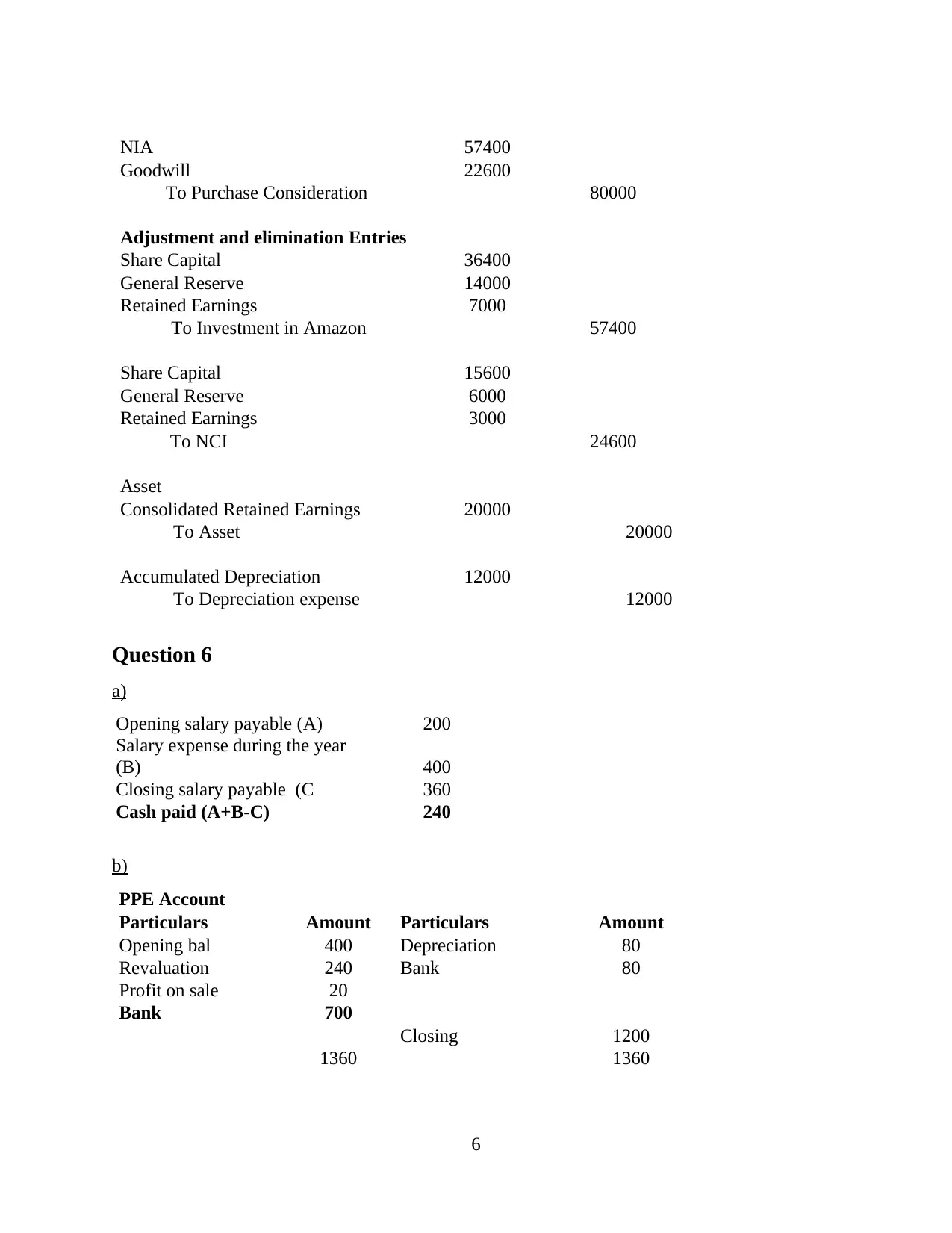
NIA 57400
Goodwill 22600
To Purchase Consideration 80000
Adjustment and elimination Entries
Share Capital 36400
General Reserve 14000
Retained Earnings 7000
To Investment in Amazon 57400
Share Capital 15600
General Reserve 6000
Retained Earnings 3000
To NCI 24600
Asset
Consolidated Retained Earnings 20000
To Asset 20000
Accumulated Depreciation 12000
To Depreciation expense 12000
Question 6
a)
Opening salary payable (A) 200
Salary expense during the year
(B) 400
Closing salary payable (C 360
Cash paid (A+B-C) 240
b)
PPE Account
Particulars Amount Particulars Amount
Opening bal 400 Depreciation 80
Revaluation 240 Bank 80
Profit on sale 20
Bank 700
Closing 1200
1360 1360
6
Goodwill 22600
To Purchase Consideration 80000
Adjustment and elimination Entries
Share Capital 36400
General Reserve 14000
Retained Earnings 7000
To Investment in Amazon 57400
Share Capital 15600
General Reserve 6000
Retained Earnings 3000
To NCI 24600
Asset
Consolidated Retained Earnings 20000
To Asset 20000
Accumulated Depreciation 12000
To Depreciation expense 12000
Question 6
a)
Opening salary payable (A) 200
Salary expense during the year
(B) 400
Closing salary payable (C 360
Cash paid (A+B-C) 240
b)
PPE Account
Particulars Amount Particulars Amount
Opening bal 400 Depreciation 80
Revaluation 240 Bank 80
Profit on sale 20
Bank 700
Closing 1200
1360 1360
6
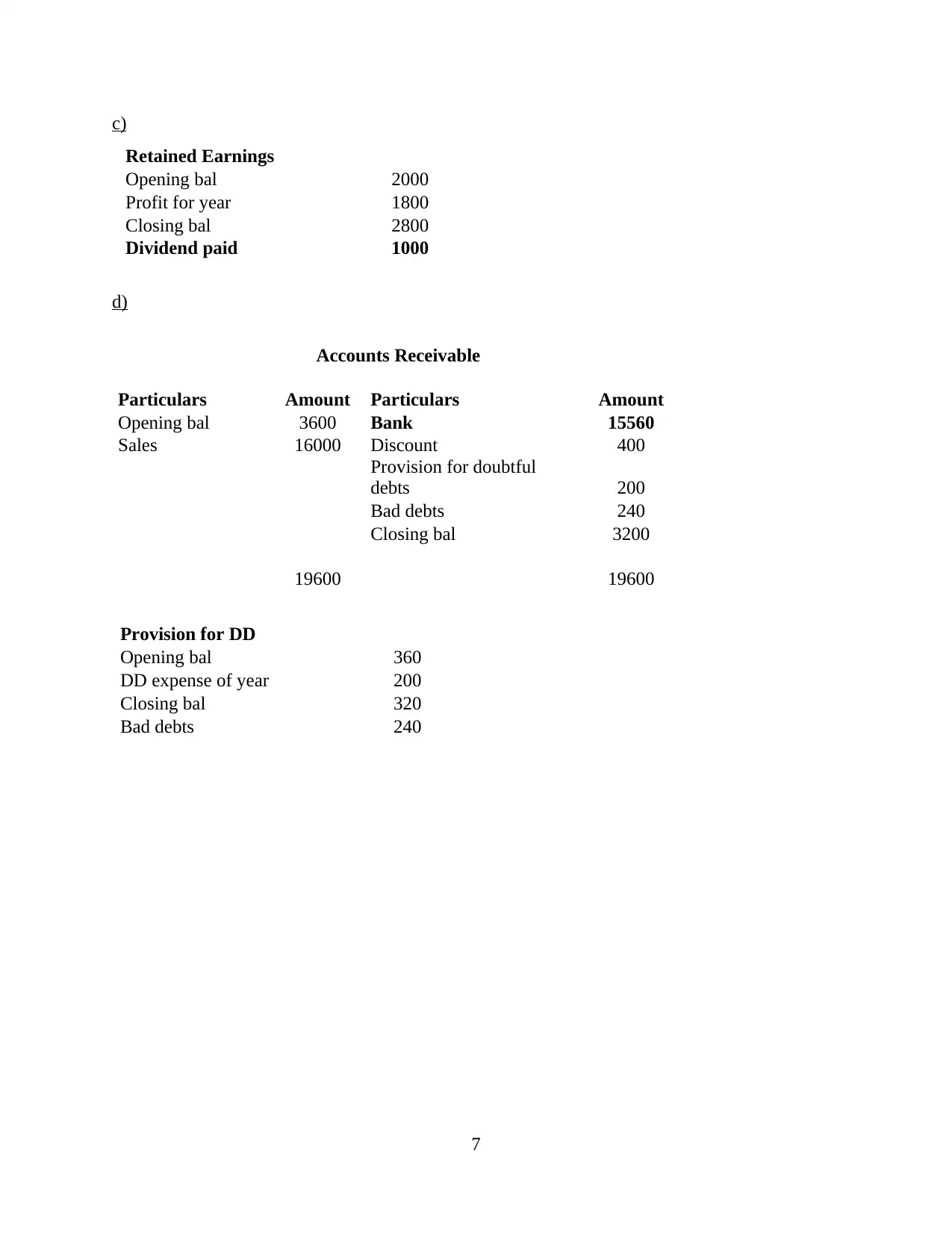
c)
Retained Earnings
Opening bal 2000
Profit for year 1800
Closing bal 2800
Dividend paid 1000
d)
Accounts Receivable
Particulars Amount Particulars Amount
Opening bal 3600 Bank 15560
Sales 16000 Discount 400
Provision for doubtful
debts 200
Bad debts 240
Closing bal 3200
19600 19600
Provision for DD
Opening bal 360
DD expense of year 200
Closing bal 320
Bad debts 240
7
Retained Earnings
Opening bal 2000
Profit for year 1800
Closing bal 2800
Dividend paid 1000
d)
Accounts Receivable
Particulars Amount Particulars Amount
Opening bal 3600 Bank 15560
Sales 16000 Discount 400
Provision for doubtful
debts 200
Bad debts 240
Closing bal 3200
19600 19600
Provision for DD
Opening bal 360
DD expense of year 200
Closing bal 320
Bad debts 240
7
⊘ This is a preview!⊘
Do you want full access?
Subscribe today to unlock all pages.

Trusted by 1+ million students worldwide

8
1 out of 10
Related Documents
Your All-in-One AI-Powered Toolkit for Academic Success.
+13062052269
info@desklib.com
Available 24*7 on WhatsApp / Email
![[object Object]](/_next/static/media/star-bottom.7253800d.svg)
Unlock your academic potential
Copyright © 2020–2025 A2Z Services. All Rights Reserved. Developed and managed by ZUCOL.




